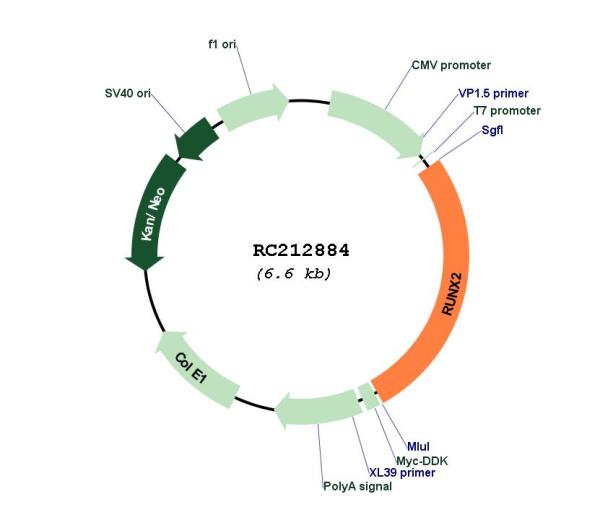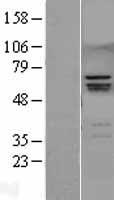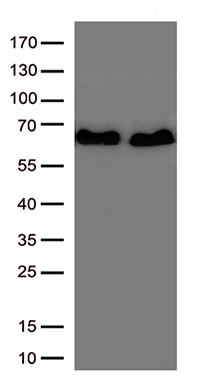RUNX2 (NM_001024630) Human Tagged ORF Clone
CAT#: RC212884
RUNX2 (Myc-DDK-tagged)-Human runt-related transcription factor 2 (RUNX2), transcript variant 1
ORF Plasmid: tGFP
"NM_001024630" in other vectors (7)
Need custom modification / cloning service?
Get a free quote
CNY 6,576.00
| Cited in 13 publications. |
CNY 300.00
CNY 1,999.00
CNY 3,600.00
Specifications
| Product Data | |
| Type | Human Tagged ORF Clone |
| Tag | Myc-DDK |
| Synonyms | AML3; CBF-alpha-1; CBFA1; CCD; CCD1; CLCD; OSF-2; OSF2; PEA2aA; PEBP2aA |
| Vector | pCMV6-Entry |
| E. coli Selection | Kanamycin (25 ug/mL) |
| Mammalian Cell Selection | Neomycin |
| Sequence Data |
>RC212884 representing NM_001024630
Red=Cloning site Blue=ORF Green=Tags(s) TTTTGTAATACGACTCACTATAGGGCGGCCGGGAATTCGTCGACTGGATCCGGTACCGAGGAGATCTGCC GCCGCGATCGCC ATGCTTCATTCGCCTCACAAACAACCACAGAACCACAAGTGCGGTGCAAACTTTCTCCAGGAGGACAGCA AGAAGTCTCTGGTTTTTAAATGGTTAATCTCCGCAGGTCACTACCAGCCACCGAGACCAACAGAGTCATT TAAGGCTGCAAGCAGTATTTACAACAGAGGGTACAAGTTCTATCTGAAAAAAAAAGGAGGGACTATGGCA TCAAACAGCCTCTTCAGCACAGTGACACCATGTCAGCAAAACTTCTTTTGGGATCCGAGCACCAGCCGGC GCTTCAGCCCCCCCTCCAGCAGCCTGCAGCCCGGCAAAATGAGCGACGTGAGCCCGGTGGTGGCTGCGCA ACAGCAGCAGCAACAGCAGCAGCAGCAACAGCAGCAGCAGCAGCAGCAACAGCAGCAGCAGCAGCAGGAG GCGGCGGCGGCGGCTGCGGCGGCGGCGGCGGCTGCGGCGGCGGCAGCTGCAGTGCCCCGGTTGCGGCCGC CCCACGACAACCGCACCATGGTGGAGATCATCGCCGACCACCCGGCCGAACTCGTCCGCACCGACAGCCC CAACTTCCTGTGCTCGGTGCTGCCCTCGCACTGGCGCTGCAACAAGACCCTGCCCGTGGCCTTCAAGGTG GTAGCCCTCGGAGAGGTACCAGATGGGACTGTGGTTACTGTCATGGCGGGTAACGATGAAAATTATTCTG CTGAGCTCCGGAATGCCTCTGCTGTTATGAAAAACCAAGTAGCAAGGTTCAACGATCTGAGATTTGTGGG CCGGAGTGGACGAGGCAAGAGTTTCACCTTGACCATAACCGTCTTCACAAATCCTCCCCAAGTAGCTACC TATCACAGAGCAATTAAAGTTACAGTAGATGGACCTCGGGAACCCAGAAGGCACAGACAGAAGCTTGATG ACTCTAAACCTAGTTTGTTCTCTGACCGCCTCAGTGATTTAGGGCGCATTCCTCATCCCAGTATGAGAGT AGGTGTCCCGCCTCAGAACCCACGGCCCTCCCTGAACTCTGCACCAAGTCCTTTTAATCCACAAGGACAG AGTCAGATTACAGACCCCAGGCAGGCACAGTCTTCCCCGCCGTGGTCCTATGACCAGTCTTACCCCTCCT ACCTGAGCCAGATGACGTCCCCGTCCATCCACTCTACCACCCCGCTGTCTTCCACACGGGGCACTGGGCT TCCTGCCATCACCGATGTGCCTAGGCGCATTTCAGATGATGACACTGCCACCTCTGACTTCTGCCTCTGG CCTTCCACTCTCAGTAAGAAGAGCCAGGCAGGTGCTTCAGAACTGGGCCCTTTTTCAGACCCCAGGCAGT TCCCAAGCATTTCATCCCTCACTGAGAGCCGCTTCTCCAACCCACGAATGCACTATCCAGCCACCTTTAC TTACACCCCGCCAGTCACCTCAGGCATGTCCCTCGGTATGTCCGCCACCACTCACTACCACACCTACCTG CCACCACCCTACCCCGGCTCTTCCCAAAGCCAGAGTGGACCCTTCCAGACCAGCAGCACTCCATATCTCT ACTATGGCACTTCGTCAGGATCCTATCAGTTTCCCATGGTGCCGGGGGGAGACCGGTCTCCTTCCAGAAT GCTTCCGCCATGCACCACCACCTCGAATGGCAGCACGCTATTAAATCCAAATTTGCCTAACCAGAATGAT GGTGTTGACGCTGATGGAAGCCACAGCAGTTCCCCAACTGTTTTGAATTCTAGTGGCAGAATGGATGAAT CTGTTTGGCGACCATAT ACGCGTACGCGGCCGCTCGAGCAGAAACTCATCTCAGAAGAGGATCTGGCAGCAAATGATATCCTGGATT ACAAGGATGACGACGATAAGGTTTAA >RC212884 representing NM_001024630
Red=Cloning site Green=Tags(s) MLHSPHKQPQNHKCGANFLQEDSKKSLVFKWLISAGHYQPPRPTESFKAASSIYNRGYKFYLKKKGGTMA SNSLFSTVTPCQQNFFWDPSTSRRFSPPSSSLQPGKMSDVSPVVAAQQQQQQQQQQQQQQQQQQQQQQQE AAAAAAAAAAAAAAAAAVPRLRPPHDNRTMVEIIADHPAELVRTDSPNFLCSVLPSHWRCNKTLPVAFKV VALGEVPDGTVVTVMAGNDENYSAELRNASAVMKNQVARFNDLRFVGRSGRGKSFTLTITVFTNPPQVAT YHRAIKVTVDGPREPRRHRQKLDDSKPSLFSDRLSDLGRIPHPSMRVGVPPQNPRPSLNSAPSPFNPQGQ SQITDPRQAQSSPPWSYDQSYPSYLSQMTSPSIHSTTPLSSTRGTGLPAITDVPRRISDDDTATSDFCLW PSTLSKKSQAGASELGPFSDPRQFPSISSLTESRFSNPRMHYPATFTYTPPVTSGMSLGMSATTHYHTYL PPPYPGSSQSQSGPFQTSSTPYLYYGTSSGSYQFPMVPGGDRSPSRMLPPCTTTSNGSTLLNPNLPNQND GVDADGSHSSSPTVLNSSGRMDESVWRPY TRTRPLEQKLISEEDLAANDILDYKDDDDKV |
| Chromatograms |
CHROMATOGRAMS
 Sequencher program is needed, download here. |
| Restriction Sites |
SgfI-MluI
Cloning Scheme for this gene
Plasmid Map

|
| ACCN | NM_001024630 |
| ORF Size | 1767 bp |
| OTI Disclaimer | Due to the inherent nature of this plasmid, standard methods to replicate additional amounts of DNA in E. coli are highly likely to result in mutations and/or rearrangements. Therefore, OriGene does not guarantee the capability to replicate this plasmid DNA. Additional amounts of DNA can be purchased from OriGene with batch-specific, full-sequence verification at a reduced cost. Please contact our customer care team at custsupport@origene.com or by calling 301.340.3188 option 3 for pricing and delivery. The molecular sequence of this clone aligns with the gene accession number as a point of reference only. However, individual transcript sequences of the same gene can differ through naturally occurring variations (e.g. polymorphisms), each with its own valid existence. This clone is substantially in agreement with the reference, but a complete review of all prevailing variants is recommended prior to use. More info |
| OTI Annotation | This clone was engineered to express the complete ORF with an expression tag. Expression varies depending on the nature of the gene. |
| Product Components | The ORF clone is ion-exchange column purified and shipped in a 2D barcoded Matrix tube containing 10ug of transfection-ready, dried plasmid DNA (reconstitute with 100 ul of water). |
| Reconstitution | 1. Centrifuge at 5,000xg for 5min. 2. Carefully open the tube and add 100ul of sterile water to dissolve the DNA. 3. Close the tube and incubate for 10 minutes at room temperature. 4. Briefly vortex the tube and then do a quick spin (less than 5000xg) to concentrate the liquid at the bottom. 5. Store the suspended plasmid at -20°C. The DNA is stable for at least one year from date of shipping when stored at -20°C. |
| Note | Plasmids are not sterile. For experiments where strict sterility is required, filtration with 0.22um filter is required. |
| Reference Data | |
| RefSeq | NM_001024630.2, NP_001019801.2 |
| RefSeq Size | 5572 bp |
| RefSeq ORF | 1566 bp |
| Locus ID | 860 |
| UniProt ID | Q13950 |
| Protein Families | Druggable Genome, Transcription Factors |
| MW | 64.44 kDa |
| Gene Summary | This gene is a member of the RUNX family of transcription factors and encodes a nuclear protein with an Runt DNA-binding domain. This protein is essential for osteoblastic differentiation and skeletal morphogenesis and acts as a scaffold for nucleic acids and regulatory factors involved in skeletal gene expression. The protein can bind DNA both as a monomer or, with more affinity, as a subunit of a heterodimeric complex. Two regions of potential trinucleotide repeat expansions are present in the N-terminal region of the encoded protein, and these and other mutations in this gene have been associated with the bone development disorder cleidocranial dysplasia (CCD). Transcript variants that encode different protein isoforms result from the use of alternate promoters as well as alternate splicing. [provided by RefSeq, Jul 2016] |
Citations (13)
| The use of this cDNA Clones has been cited in the following citations: |
|---|
|
RUNX2 interacts with BRG1 to target CD44 for promoting invasion and migration of colorectal cancer cells
,Yan, X;Han, D;Chen, Z;Han, C;Dong, W;Han, L;Zou, L;Zhang, J;Liu, Y;Chai, J;,
Cancer Cell Int
,PubMed ID 33071648
[RUNX2]
|
|
Gain-of-function variants and overexpression of RUNX2 in patients with nonsyndromic midline craniosynostosis
,Cuellar, A;Bala, K;Di Pietro, L;Barba, M;Yagnik, G;Liu, JL;Stevens, C;Hur, DJ;Ingersoll, RG;Justice, CM;Drissi, H;Kim, J;Lattanzi, W;Boyadjiev, SA;,
Bone
,PubMed ID 32360898
[RUNX2]
|
|
A Potential Role of RUNX2- RUNT Domain in Modulating the Expression of Genes Involved in Bone Metastases: An In Vitro Study with Melanoma Cells
,Deiana, M;Dalle Carbonare, L;Serena, M;Cheri, S;Mutascio, S;Gandini, A;Innamorati, G;Lorenzi, P;Cumerlato, M;Bertacco, J;Antoniazzi, F;Romanelli, MG;Mottes, M;Zipeto, D;Valenti, MT;,
Cells
,PubMed ID 32204402
[RUNX2]
|
|
Htra1 is a Novel Transcriptional Target of RUNX2 That Promotes Osteogenic Differentiation
,Iyyanar, PPR;Thangaraj, MP;Eames, BF;Nazarali, AJ;,
Cell. Physiol. Biochem.
,PubMed ID 31703162
[RUNX2]
|
|
MiR-122 inhibits cell proliferation and induces apoptosis by targeting runt-related transcription factors 2 in human glioma
,DING, CQ;DENG, WS;YIN, XF;,
European Review for Medical and Pharmacological Sciences
,PubMed ID 30070328
[RUNX2]
|
|
Runx2 mediated Induction of Novel Targets ST2 and Runx3 Leads to Cooperative Regulation of Hypertrophic Differentiation in ATDC5 Chondrocytes
,Bonyadi Rad, E;Musumeci, G;Pichler, K;Heidary, M;Szychlinska, MA;Castrogiovanni, P;Marth, E;Böhm, C;Srinivasaiah, S;Krönke, G;Weinberg, A;Schäfer, U;,
Sci Rep
,PubMed ID 29263341
[RUNX2]
|
|
Mutant Runx2 regulates amelogenesis and osteogenesis through a miR-185-5p-Dlx2 axis
,Chang, H;Wang, Y;Liu, H;Nan, X;Wong, S;Peng, S;Gu, Y;Zhao, H;Feng, H;,
Cell Death Dis
,PubMed ID 29242628
[RUNX2]
|
|
Runt-related transcription factor 2 (RUNX2) inhibits apoptosis of intestinal epithelial cells in Crohn's disease
,Gu, L;Zhao, J;Zhang, S;Xu, W;Ni, R;Liu, X;,
Pathol. Res. Pract.2017
,PubMed ID 29129496
[RUNX2]
|
|
Improvement of osteogenesis in dental pulp pluripotent-like stem cells by oligopeptide-modified poly(β-amino ester)s
,Núñez-Toldrà, R;Dosta, P;Montori, S;Ramos, V;Atari, M;Borrós, S;,
Acta Biomater
,PubMed ID 28159719
[RUNX2]
|
|
The membrane protein melanoma cell adhesion molecule (MCAM) is a novel tumor marker that stimulates tumorigenesis in hepatocellular carcinoma
,Wang, J;Tang, X;Weng, W;Qiao, Y;Lin, J;Liu, W;Liu, R;Ma, L;Yu, W;Yu, Y;Pan, Q;Sun, F;,
Oncogene
,PubMed ID 25728681
[RUNX2]
|
|
Tumor suppressor long non-coding RNA, MT1DP is negatively regulated by YAP and Runx2 to inhibit FoxA1 in liver cancer cells
,Yu, W;Qiao, Y;Tang, X;Ma, L;Wang, Y;Zhang, X;Weng, W;Pan, Q;Yu, Y;Sun, F;Wang, J;,
Cell. Signal.
,PubMed ID 25261601
[RUNX2]
|
|
Instructive nanofibrous scaffold comprising runt-related transcription factor 2 gene delivery for bone tissue engineering.
,null,
ACS nano
,PubMed ID 25046548
[RUNX2]
|
|
Runx2 is a novel regulator of mammary epithelial cell fate in development and breast cancer
,Owens, TW;Rogers, RL;Best, S;Ledger, A;Mooney, AM;Ferguson, A;Shore, P;Swarbrick, A;Ormandy, CJ;Simpson, PT;Carroll, JS;Visvader, JE;Naylor, MJ;,
Cancer Res. July 2014
,PubMed ID 25056120
[RUNX2]
|
Documents
| Product Manuals |
| FAQs |
| SDS |
Resources
Other Versions
| SKU | Description | Size | Price |
|---|---|---|---|
| RC212884L1 | Lenti ORF clone of Human runt-related transcription factor 2 (RUNX2), transcript variant 1, Myc-DDK-tagged |
CNY 8,976.00 |
|
| RC212884L2 | Lenti ORF clone of Human runt-related transcription factor 2 (RUNX2), transcript variant 1, mGFP tagged |
CNY 8,976.00 |
|
| RC212884L3 | Lenti ORF clone of Human runt-related transcription factor 2 (RUNX2), transcript variant 1, Myc-DDK-tagged |
CNY 8,976.00 |
|
| RC212884L4 | Lenti ORF clone of Human runt-related transcription factor 2 (RUNX2), transcript variant 1, mGFP tagged |
CNY 8,976.00 |
|
| RG212884 | RUNX2 (tGFP-tagged) - Human runt-related transcription factor 2 (RUNX2), transcript variant 1 |
CNY 8,176.00 |
|
| SC302270 | RUNX2 (untagged)-Human runt-related transcription factor 2 (RUNX2), transcript variant 1 |
CNY 18,664.00 |
|
| SC318014 | RUNX2 (untagged)-Human runt-related transcription factor 2 (RUNX2), transcript variant 1 |
CNY 6,592.00 |


 United States
United States
 Germany
Germany
 Japan
Japan
 United Kingdom
United Kingdom
 China
China




